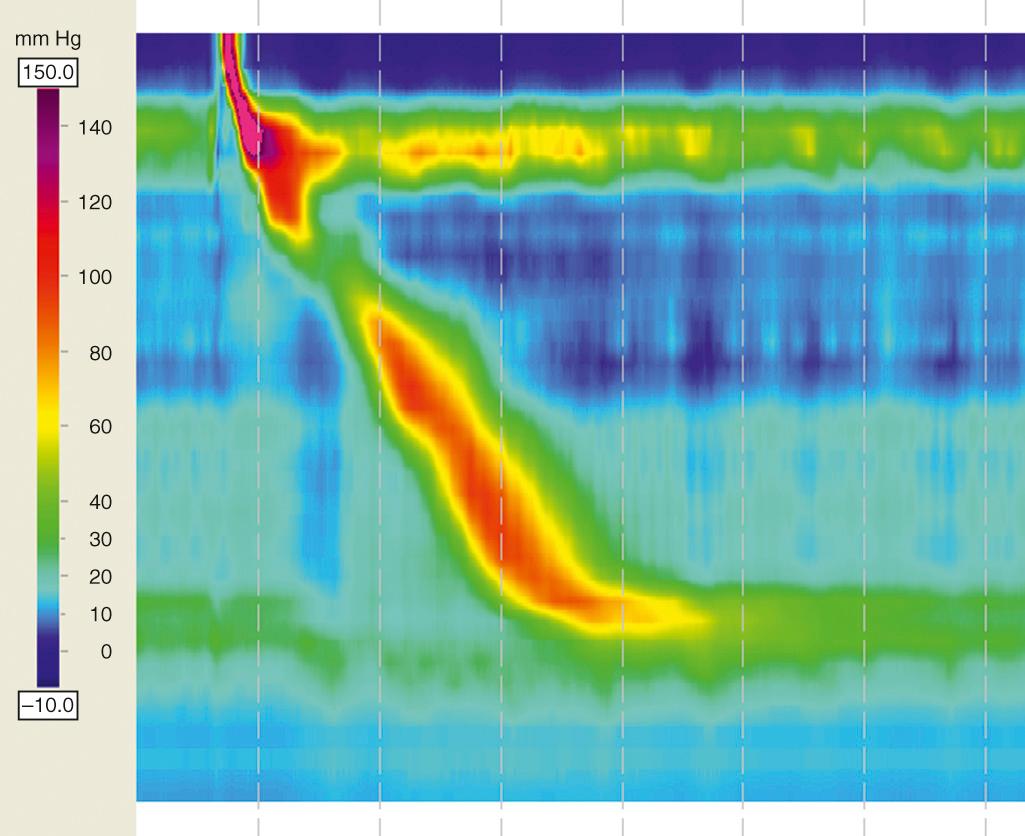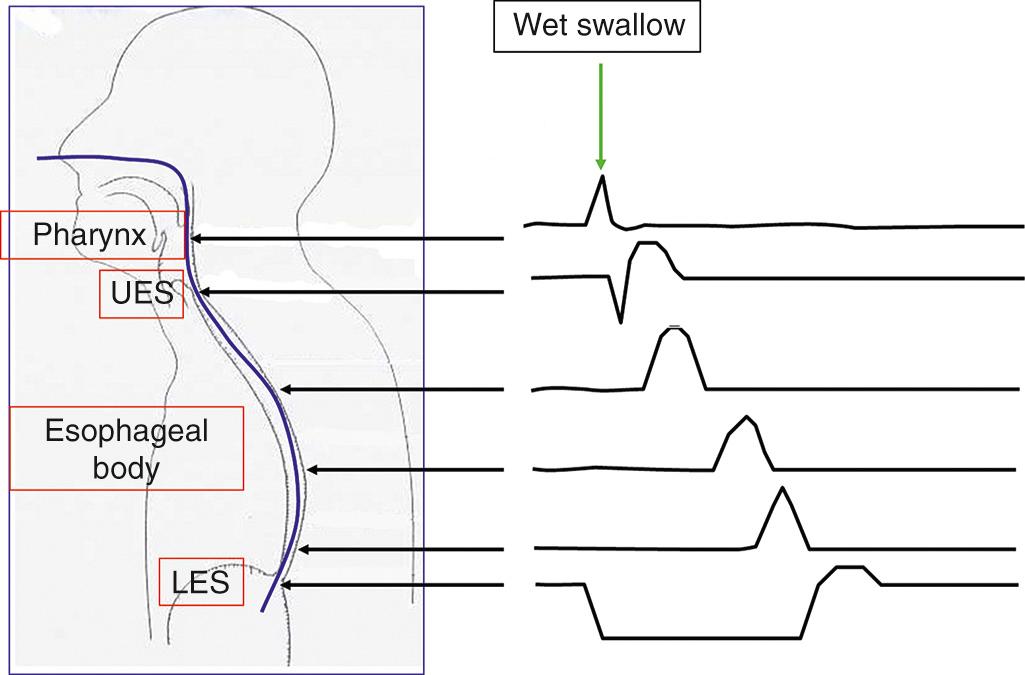Physical Address
304 North Cardinal St.
Dorchester Center, MA 02124
High-resolution manometry (HRM) is a well-established diagnostic tool that evaluates esophageal motility. It dynamically measures intraluminal pressure changes in the esophagus by using closely spaced pressure sensors. Data are acquired, displayed, and interpreted by esophageal pressure topography plots.
The Chicago Classification aims to define esophageal motility disorders according to HRM findings. This classification was first proposed in 2008 and then updated in 2011 and in 2014. The latest version, the Chicago Classification, version 3.0, evaluates new parameters when compared with the previous versions, including esophagogastric junction (EGJ) morphology and contractility at rest, “fragmented” contractions, and ineffective esophageal motility (IEM). This classification categorizes (1) disorders of the EGJ outflow, such as achalasia and EGJ outflow obstruction, (2) major peristalsis disorders such as absent contractility, distal esophageal spasm and hyper contractile esophagus, and (3) minor disorders characterized by impaired bolus transit.
The aim of this chapter is to review the esophageal function in the healthy esophagus and in the most frequent esophageal motility disorders.
The evaluation of esophageal motility by HRM is based on the assessment of ten 5-mL water swallows performed in supine position ( Fig. 2.1 ). During each swallow the following features are evaluated:
EGJ relaxation
esophageal contractile activity
esophageal pressurization

The pressure topographic measurements used are
integrated relaxation pressure (IRP)
distal contractile integral (DCI)
contractile deceleration point (CDP)
distal latency (DL)
During swallowing, the pressure detected at the level of the EGJ is defined by lower esophageal sphincter (LES) pressure, contraction of crural diaphragm (CD), and intrabolus pressure as the swallowed bolus passes through the EGJ. IRP, defined as the mean pressure for the 4 seconds of maximal deglutitive relaxation in the 10-second window starting with deglutitive upper esophageal sphincter (UES) relaxation, is the best metric to differentiate between normal and impaired EGJ relaxation. IRP is influenced not only by LES relaxation but also by CD contraction and intrabolus pressure. In addition, normal values depend on the HRM device used: the upper limit value in normal subjects varies between the transducer used, ranging from 15 mm Hg in the Sierra design transducers to 28 mm Hg in the Unisensor design transducers in the supine position.
The EGJ can be classified into three subtypes based on the axial relationship between the LES and CD :
Type I : LES and CD are completely overlapped.
Type II : LES and CD are separated, with the separation between the pressure peaks being 2 cm or less.
Type III : the separation between LES and CD is greater than 2 cm.
Type IIIa : the pressure inversion point remains at the level of CD.
Type IIIb : the pressure inversion point is localized at the level of LES.
When food passes through the UES, a contraction is initiated in the upper esophagus, which progresses distally toward the stomach ( Fig. 2.2 ). The wave initiated by swallowing is referred as primary peristalsis. It travels at a speed of 3 to 4 cm/s and reaches amplitudes of 60 to 140 mm Hg in the distal esophagus. Local stimulation by distention at any point in the body of the esophagus will elicit a peristaltic wave from the point of stimulus. This is called secondary peristalsis and aids esophageal emptying when the primary wave has failed to clear the lumen of ingested food, or when gastric contents reflux from the stomach. Tertiary waves are considered abnormal, but they are frequently seen in elderly people who have no symptoms of esophageal disease.

Postdeglutitive esophageal contraction is evaluated by using the following metrics:
CDP represents the inflection point in the contractile front propagation velocity in the distal esophagus.
DL represents the interval between UES relaxation and the CDP. It is considered an important metric indicating the integrity of the inhibitory pathway in the distal esophagus. A value less than 4.5 seconds defines a premature contraction, indicative of spasm.
DCI describes the vigor of the distal esophageal contraction. It is measured as the “volume” of the esophageal contraction spanning from the transition zone to the EGJ. The DCI is the product of the integral of the amplitude exceeding 20 mm Hg, the duration, and the length of the contractile segment between the transition zone and the EGJ. Cutoff values defining different diagnostic categories depend on the type of HRM hardware and software used. DCI in normal subjects ranges between 450 and 8000 mm Hg-s-cm. Hypercontractility is defined by a DCI greater than 8000 mm Hg-s-cm. A DCI ranging between 100 and 450 mm Hg-s-cm defines weak peristalsis, whereas a DCI lower than 100 mm Hg-s-cm identifies failed peristalsis. Both failed and weak contractions are considered ineffective.
Contraction integrity, contraction pattern, and intrabolus pressure pattern characterize each swallow. Contraction integrity is defined based on the integrity of the 20-mm Hg isobaric contour. Small (2 to 5 cm in length) interruptions, or breaks, in the 20-mm Hg isobaric contour between the UES and EGJ are considered normal, whereas large (>5 cm in length) breaks define weak contractions. The associated intrabolus pressure pattern is assessed using the 30-mm Hg isobaric contour. Intrabolus pressure is qualified as panesophageal pressurization if it spans from UES to EGJ and as compartmentalized pressurization if it is restricted to the segment between the deglutitive contractile front and the EGJ.
Become a Clinical Tree membership for Full access and enjoy Unlimited articles
If you are a member. Log in here